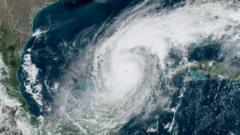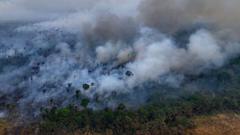A recent study highlights the concept of "atmospheric thirst" as a significant factor worsening droughts, driven by climate change-induced temperature increases. Agricultural practices, particularly older irrigation systems, are struggling to meet contemporary crop water demands.
Drought Dynamics: Understanding 'Atmospheric Thirst' and Climate Change Effects

Drought Dynamics: Understanding 'Atmospheric Thirst' and Climate Change Effects
New research reveals how rising temperatures contribute to more severe drought conditions.
As climate change continues to shape weather patterns, a new study has illuminated the concept of "atmospheric thirst," suggesting that higher temperatures are exacerbating drought conditions across agricultural regions. This phenomenon refers to the increased capacity of warm air to draw moisture from the soil, thereby intensifying the severity and frequency of droughts.
Observing the Great Plains and Western United States from above reveals a patchwork of crops irrigated by advanced center-pivot sprinkler systems. However, farmers are reporting challenges, particularly with older irrigation technologies that are failing to meet the increasing water demands of crops in today's hotter climate, as noted by Meetpal Kukal, an agricultural hydrologist at the University of Idaho. "There's a gap between how much water you can apply and what the crop demands are," he explained.
According to Solomon Gebrechorkos, a hydroclimatologist at the University of Oxford and lead author of the study published in the journal Nature, this atmospheric thirst factor has evolved significantly over the last 40 years, resulting in larger and more frequent droughts. The relationship between rainfall and evaporation is governed by a complex interplay of various elements, including temperature, wind, humidity, and solar radiation. Traditionally, drought studies have focused solely on precipitation, neglecting to account for how much moisture is being evaporated from the soil into the atmosphere.
The insights offered by this research reveal that managing water resources and agricultural practices in an era marked by climate change necessitates a broader understanding of water balance. Dr. Gebrechorkos likens this to examining a financial budget without considering expenses; one cannot fully comprehend the water supply situation without addressing both rainfall and atmospheric evaporation dynamics. This shift in understanding is crucial for adapting farming techniques and ensuring sustainable water usage in the face of increasing temperatures and the potential for more severe drought conditions.



















